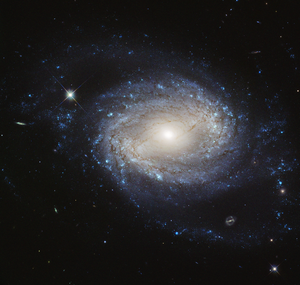NGC 4639
| Galaxy NGC 4639 |
|
|---|---|

|
|
| Photo from the Hubble Space Telescope | |
| AladinLite | |
| Constellation | Virgin |
|
Position equinox : J2000.0 , epoch : J2000.0 |
|
| Right ascension | 12 h 42 m 52.4 s |
| declination | + 13 ° 15 ′ 27 ″ |
| Appearance | |
| Morphological type | SAB (rs) bc / Sy1.0 |
| Brightness (visual) | 11.4 mag |
| Brightness (B-band) | 12.2 mag |
| Angular expansion | 2.9 'x 2.0' |
| Position angle | 123 ° |
| Surface brightness | 13.2 mag / arcmin² |
| Physical data | |
| Affiliation | Virgo cluster Messier 87 group NGC 4639 group NGC 4486 group LGG 289 |
| Redshift | 0.003395 ± 0.000018 |
| Radial velocity | 1018 ± 5 km / s |
|
Stroke distance v rad / H 0 |
(43 ± 3) · 10 6 ly (13.3 ± 0.9) Mpc |
| diameter | 45,000 ly |
| history | |
| discovery | Wilhelm Herschel |
| Discovery date | April 12, 1784 |
| Catalog names | |
| NGC 4639 • UGC 7884 • PGC 42741 • CGCG 070-230 • MCG + 02-32-189 • IRAS 12403 + 1331 • 2MASX J12425235 + 1315271 • VCC 1943 • GC 3173 • H II 125 • h 1403 • HIPASS J1243 + 13a • LDCE 904 NED233 | |
NGC 4639 is a bar-spiral galaxy with an active nucleus of the Hubble-type SBbc in the constellation Virgo north of the ecliptic . It is estimated to be 43 million light years from the Milky Way and about 35,000 light years in diameter. In their outer area, Cepheids can be observed. It is listed as a member of the Virgo galaxy cluster under catalog number VVC 1943 .
In the same area of the sky are u. a. the galaxies NGC 4611 , NGC 4620 , NGC 4654 , NGC 4659 .
The Type Ia supernova SN 1990N was observed here.
The object was discovered on April 12, 1784 by the German-British astronomer Wilhelm Herschel .
Web links
- SIMBAD Astronomical Database
- Hubble Space Telescope
- astronews.com: Picture of the day October 13, 2015
